These perfectly timed moments show us the wild side of animal photography
Science
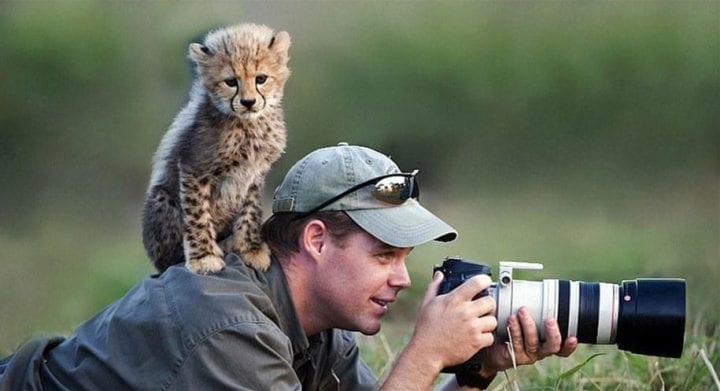
1. When you’re near Antarctica, it’s nice to have a butt warmer
Demilked
Life as a wildlife photographer is full of excitement and special moments — in between the long hours of trekking through tough terrain and waiting in less than ideal weather conditions. Sometimes, though, everything aligns for a perfect moment. Animals get sick of being the models and get curious about the photographers.
Photographer Art Wolfe lays on a rocky beach, inches from freezing water. He’s trying to take a shot of a couple southern elephant seals splashing around, but one has decided to climb on his back. “Ow!” he says, but the other photographer, crouched in the water, snaps a great shot of Wolfe and the seal.
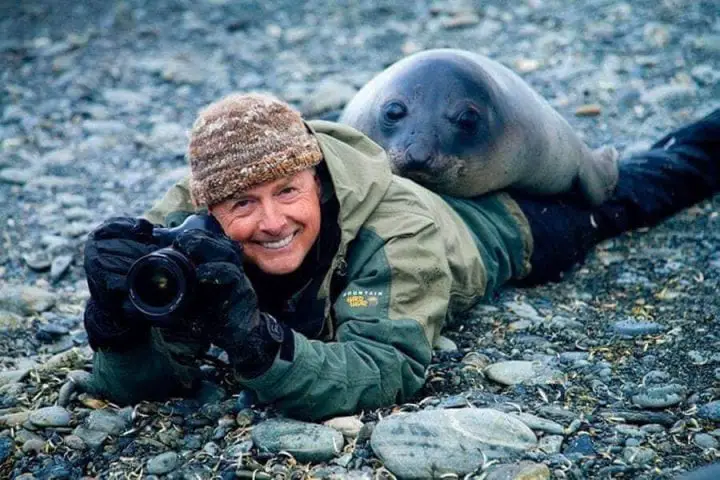
Art Wolfe
Penguins mill around in the background while Wolfe and his crew film South Georgia island and its wildlife. The island is situated in the nearly polar waters of the South Atlantic Ocean, close to Antarctica and the tip of South America. The largest of all seals, male southern elephant seals can get up to 8,800 pounds.
2. “Yeah, that’s a good shot right there”
Mtombi the cheetah lives at the Tshukudu Game Lodge in South Africa, which is both a hotel and a nature reserve. Mtombi was rescued, but she still runs wild and hunts for herself. Photographer Chris du Plessis was taking pictures of the animals at the reserve when he saw she had been laying still on the ground for a while.
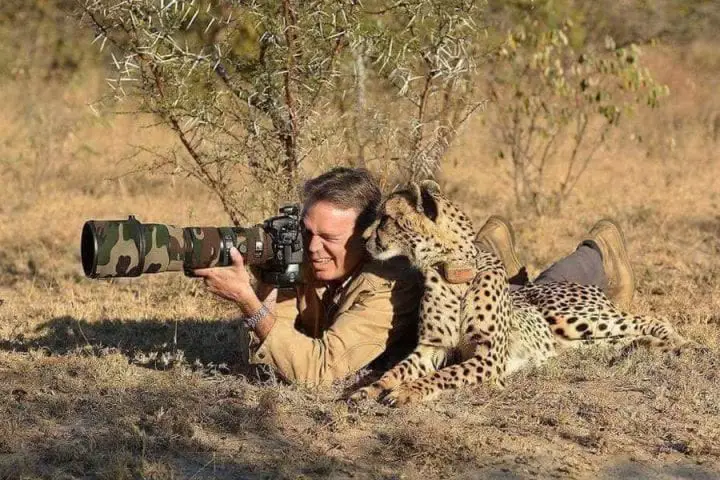
Chris Du Plessis
The photographer lay next to Mtombi and pretended to take pictures while taking the actual photos with a remote device. She was purring and apparently sniffing out a nearby pride of lions. Cheetahs and cougars are the only big cats that can purr, but they can’t roar like lions and tigers.
3. Please don’t peck the really expensive lens
Alexander Sviridov took about three or four hours to get a couple of great selfies with tiny little birds. He put some bird seed near the lens of his camera, hoping the birds would come land on it, because not everyone can be Snow White and just randomly attract cute wild animals.
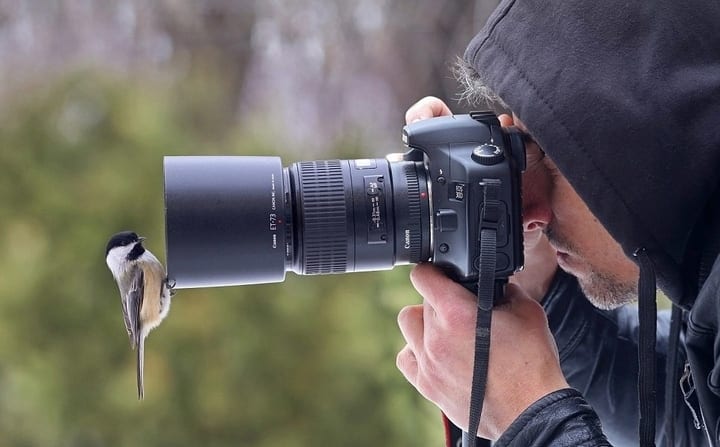
Alexander Sviridov
To get the perfect shot, Sviridov set up a second camera with remote control. This little bird is a black-capped Chickadee, who lives in southern Canada and the northern United States. They’re named after a call they make that sounds like chickadee-dee-dee. Chickadees are social, living in flocks of their own species and around other types of birds.
4. Sometimes the animals are just really curious
In the Romanian Carpathian mountains, National Geographic photographer Onofras Ionel was looking for something spectacular to shoot. Instead, he ended up with quite a comical picture. The deer approached him and he wasn’t quite sure what to think of it, then she stuck her face in his lens.
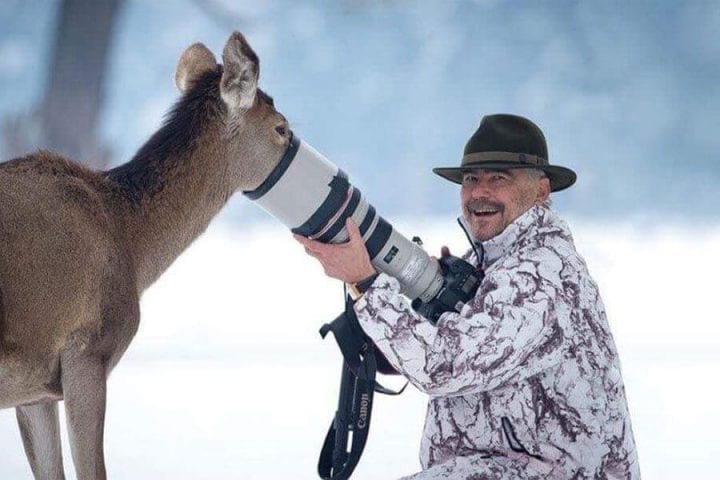
Onofras Ionel
He didn’t bait it with any food, but perhaps she’d had run-ins with other photographers who had. She must have licked his lens, because when Ionel looked at it after she left, it was frozen over with saliva! If you’re ever in the neighborhood of the Romanian Carpathians, Ionel gives wildlife tours.
5. Camera lenses make great hidey-holes
Dalia Kvedaraite and Giedrius Stakauskas were on a mission to take pictures of red squirrels in the snow, so they went to Yorkshire Dales National Park in northern England. They got a local hotel room and then headed out into the woods. As if on cue, it started to snow. Large snowflakes actually made it hard to focus the camera, but they still got plenty of beautiful shots.
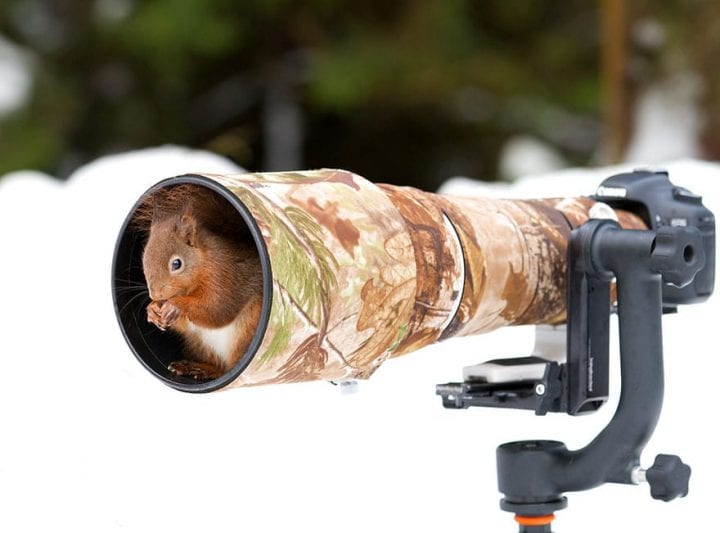
Dalia Kvedaraite and Giedrius Stakauskas
Unfortunately, one of their cameras stopped working, so the photographers came up with a new way to use it. They put a couple of peanuts in the lens hood and a curious squirrel came over and checked it out. The photographers were only a little worried about the squirrel scratching the very, very expensive lens, but luckily the camera got out of it alive.
6. Leave it to beaver to get the best shot
It takes a very patient person to do wildlife photography. Leopold Kanzler of Vienna, Austria took two weeks to snap this shot. He worked by hiding apple slices in the camera to get the beaver interested. This wasn’t his first time photographing beavers, so he knew their behavior well enough to compose the photo.
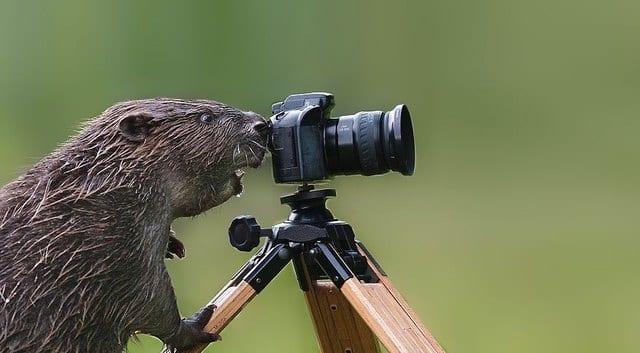
Leopold Kanzler
“I’m not sure who had more fun, me or the beaver, but it seemed more than happy with receiving so many tasty treats,” Kanzler said. With his photography, Kanzler hopes to make people more aware of the need to conserve nature by showing its beauty and charm.
7. No one likes a backseat photographer
Photographer Will Burrard-Lucas is from the UK, but he spent part of his childhood in Tanzania, where he fell in love with African wildlife. One of his favorite animals is the adorable meerkat, a type of mongoose. They’re funny little mammals that live above and below ground on the African savanna.
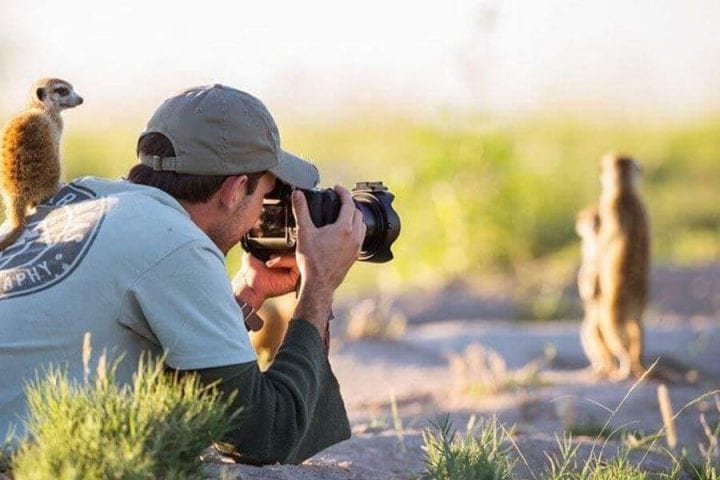
Will Burrard-Lucas
One (fictional) meerkat even achieved stardom — as Timon in “The Lion King.” But Timon was a bit unusual, because most meerkats live in large groups of about 40 or so. Together, the meerkats live in burrows underground, where they even have separate chambers for sleeping and relieving themselves.
8. Wildlife photography is all fun and games until the camera gets hurt
This here is an example of what happens when a wedding photographer tries his hand at wildlife photography. Ed Hetherington went to Zimbabwe to get some sweet animal pics, but things did not go according to plan. He saw an opportunity when a lioness took down a buffalo and wandered off for a moment. Ed set up his camera next to the buffalo to get up-close shots.
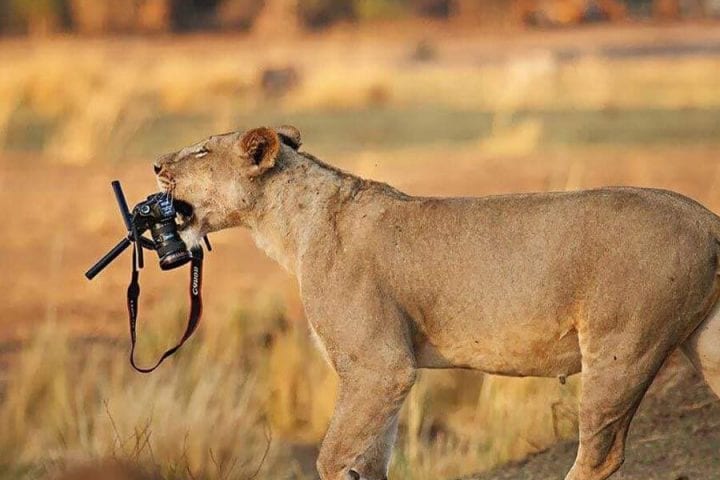
Ed Hetherington
He hurried back to a safe distance, using remote triggering to take the pictures. Unfortunately, the only photos he got were of the lioness coming over and stealing his camera. But at that point, there was nothing Ed could do except take photos of her sauntering off with his equipment. She broke the camera, but the lens and memory card survived.
9. The animals might sneak up behind you
Marion Klette and her friend Tommy Angelsen were taking photos of foxes when one snuck up behind her. Luckily, Tommy snapped the moment, getting a great couple of pictures. Marion, on the other hand, got some less popular photos of the foxes (and one nosey fox) for her troubles.
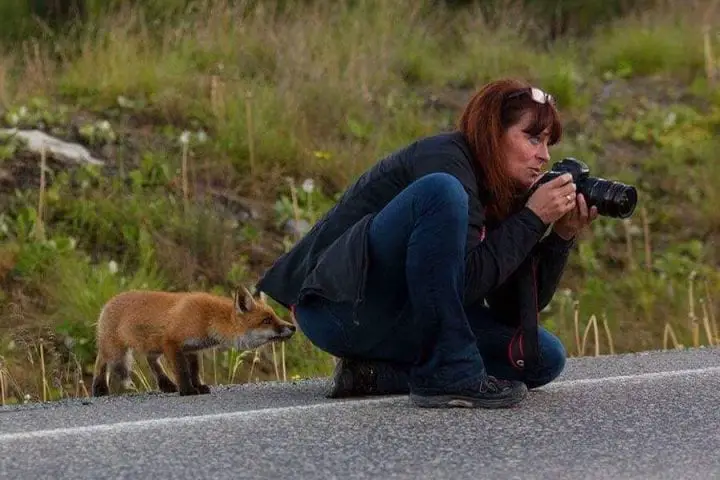
Tommy Angelsen
“When we then approached [the foxes], they toyed around with us for a little while,” Angelsen said to Express. “That’s the best thing about photographing foxes: you never know what they are going to do next.” It’s no wonder foxes feature so prominently in wildlife photographer interruptions; they’re feisty and curious.
10. “I can see danger much better from up here”
Will Burrard-Lucas visited the Botswana meerkats several times, getting up-close shots of their lives. It’s surprising the meerkats learned to not be afraid of humans, because Will loomed over them with his huge camera, even when he was laying on the ground. It’s especially curious, because meerkats spend a good amount of their time on the lookout for danger.

Will Burrard-Lucas
Meerkats are constantly concerned about eagles, jackals, or falcons coming to get them, so the adults take turns as lookout. The guard will find the highest spot to stand on while everyone else is foraging for food, but sometimes the highest spot is a photographer’s camera.
11. This fox was more than ready for his close-up
Photographer Dan Dinu and a few of his trainees drove into the forested area around St. Ana Lake in Romania. They took various photos of the wintery landscape, not expecting to shoot much wildlife. They had heard a friendly fox lived in the area, but didn’t expect to see him. But when they started driving back home, he appeared on the road.
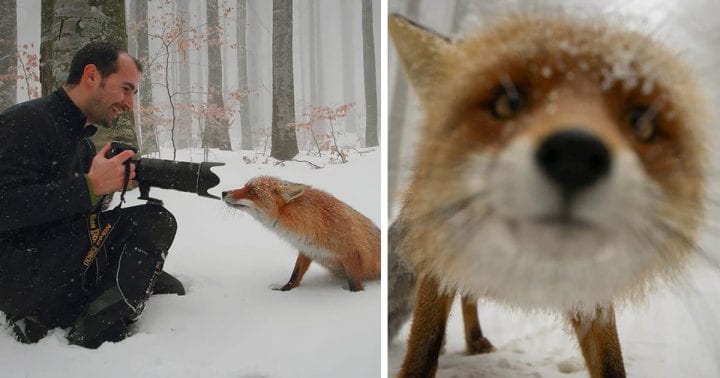
Dan Dinu
When they stopped the car, the fox actually came closer, so Dan and the other photographers snapped pictures of it. The fox nearly stuck his face in the lens. So why was he so friendly? Well, this fox had been raised by a forest ranger, so he was used to humans. Despite that, when other cars stopped to watch, the fox ran away into the forest.
12. Koalas have big dreams, too
The camera crew for Australia’s TV news channel NBN Television was filming at a reptile park when a koala commandeered the camera. At first, it looked like he was going to put his own creative spin on the filming style, but then he just started climbing on the camera.
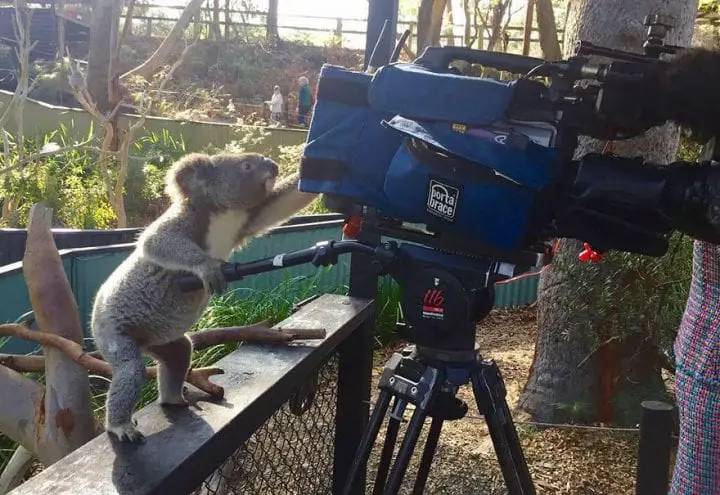
D_S_W/Reddit
Where did this koala even come from? That’s just another mystery of Australia. Koalas, like kangaroos, are marsupials, which means they carry their babies in a pouch on their bellies. Koalas are also pretty picky: they only live in Australia and only eat eucalyptus leaves. There are about 600 kinds of eucalyptus trees, though, so at least they can pick out some slightly different flavors.
13. Sometimes the models are smaller than the camera
Laying on his belly in the dirt, Will Burrard-Lucas snuggles his camera up against the ground. Young and curious, baby meerkats come over to investigate, sticking their noses into the lens. Will had been visiting the babies for a while, so they were used to him.
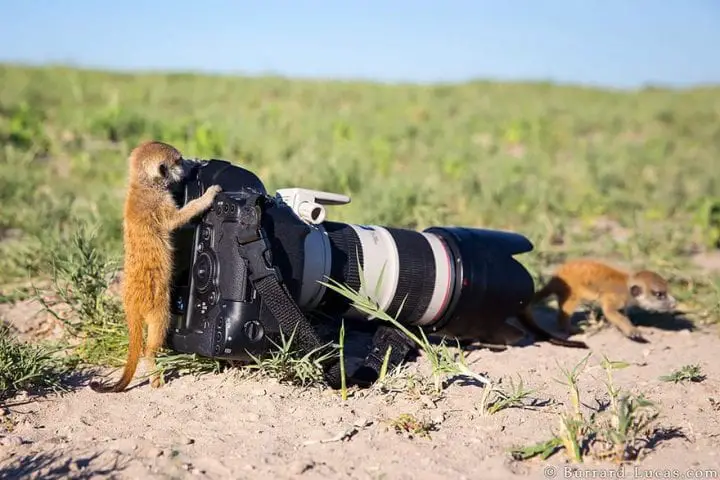
Will Burrard Lucas
He let the baby meerkats take the reins since they were so interested in his camera. They chirped to each other, crawling all over everything, before eventually going back underground. Meerkats have special membranes that cover their eyes to protect them from dirt while they dig. Plus, their ears close to also keep dirt out, perfectly suited for their habitat.
14. “Hey what’s in here?”
Kangaroos famously carry their babies (aka “joeys”) around in their pouches. The babies are born into the pouch, ranging in size from a grain of rice to the size of a bee, where they then grow and drink the mother’s milk. Amazingly, a mother kangaroo can sustain two joeys of different ages, with milk of different nutritional content at the same time.
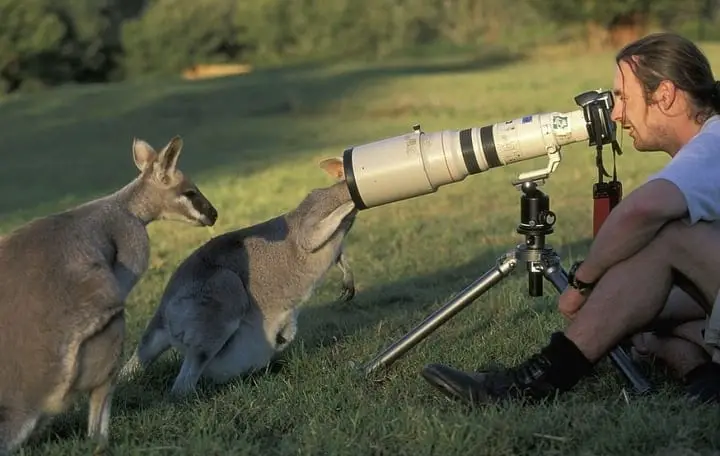
Tony Heenon
Curiously, kangaroo mothers sometimes adopt joeys in the wild. As far as scientists can tell, it seems like this generally happens in a crisis when the wrong joey hops into a mother’s pouch. Kangaroo mothers aren’t particularly great at knowing which joey is theirs because usually they just do a simple sniff test, but when danger threatens, there isn’t always enough time to sniff. And then she hops off with the wrong joey.
15. Cats will sit on you at any chance they get
Cheetahs are widely known as the fastest land animal since they can reach speeds up to 70 miles per hour, but how do they run so fast? These cats have very flexible skeletons that make it so their front legs can stretch far forward. Plus, their claws are like cleats: hard and sharp, and they never fully retract.

Stu Porter
But not only are cheetahs extraordinarily fast, they’re also amazingly agile at such high speeds. Greyhounds and horses don’t come close to the cheetah’s maneuverability. They can speed up very quickly and suddenly slow down with ease, allowing them to make tight turns while hunting.
16. This budding photographer is barely tall enough for the tripod
Foxes are very good at adapting to the changing world. Normally, they live in forests, grasslands, and mountains, but they’ve also made homes in farms and suburban communities. They’ll eat just about anything, from rodents and birds to fruits and garbage.

Post Fun
A fox’s bushy tail is great for balance, but it also acts as a blanket in cold weather as well as a signal to other foxes. Unlike many animals, both red fox parents care for their young. They dig burrows in the ground to sleep in safely while raising the family. Also, foxes are incredibly fast; some can run at 40 miles per hour.
17. Sometimes a photo shoot turns into a Disney movie
Wolves may be the stuff of nightmares for some people, specifically people from the 1800s, but they have their Disney moments, too. They are very social since they live in packs of about six to ten wolves. And generally, wolves hunt animals like deer, elk, and moose (although sometimes they eat birds, reptiles, fruit, and small mammals).
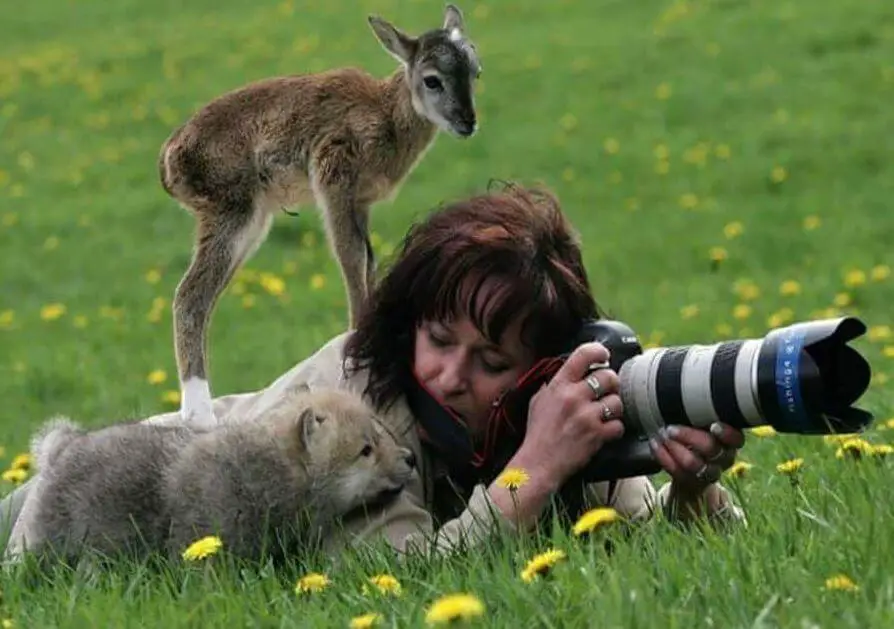
Liba Radova
Elk, white-tailed deer, and moose all belong to the family Cervidae, because they are closely related. White-tailed deer move quickly, leaping and bounding through the forest. Elk are large and travel in herds, plus they have shaggy necks. Moose are the largest of all cervids and live alone.
18. Tiny photography assistants can help get the best shot
Indiana Jones, the baby capuchin monkey, decided to snap a photo with his trainer Ben Britton’s camera. There are several species of capuchin monkey, but they all live in Central and South America. Capuchins are popular monkeys in showbiz, but make poor pets. They’re very social animals, so it’s probably not great to keep one separate from any other monkeys.
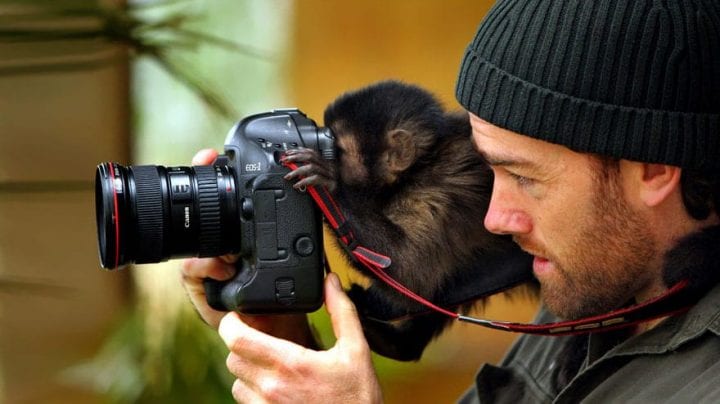
Gregg Porteous
Capuchin monkeys make up traditions and ways to bond that are unique to their group and passed down through the generations. One example is eyeball-poking, in which one monkey will literally poke into another’s eye socket. While that practice is a bit disturbing to us humans, these monkeys do something else that’s similar to our own behavior: use tools.
19. “Maybe I can store my nuts in this?”
In the United Kingdom, there’s a bit of a squirrel problem. Victorians brought grey squirrels to the islands in the 1800s and since then, native red squirrels have been pushed out of their territory. The two species compete for food and shelter, plus the grey squirrels transmit disease to their red cousins.
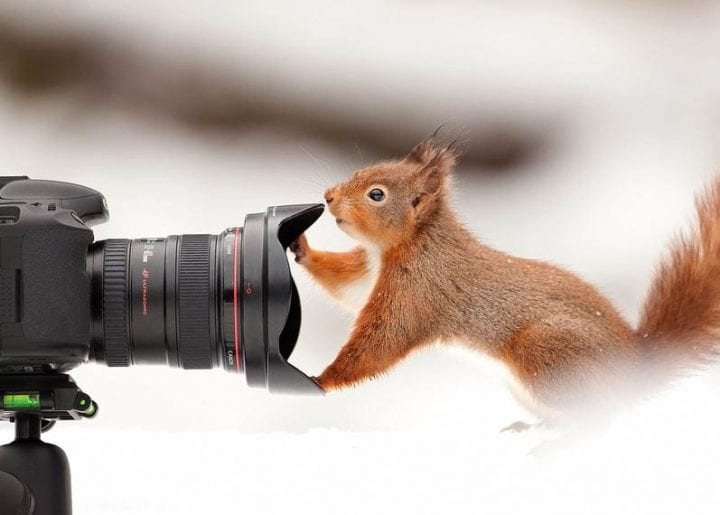
Dalia Kvedaraite and Giedrius Stakauskas
There are actually two red squirrel species: one in North America and one in Europe. The North American red squirrel luckily faces no threats at the moment. Red squirrels are smaller than other tree squirrels and sometimes they bite into maple trees to drink the sap. Clearly, they have good taste, since they like real maple syrup.
20. You may get kisses… or a bite on the nose
Who wouldn’t want kisses from a baby weasel? This photographer certainly didn’t mind the interruption. Weasels are part of the Mustelid family, which includes badgers, otters, and ferrets. There are several species of weasel, but they all turn white in the winter. Since their bodies don’t really store any fat, they have to hunt and eat a lot. They’ll also stash excess food for later.
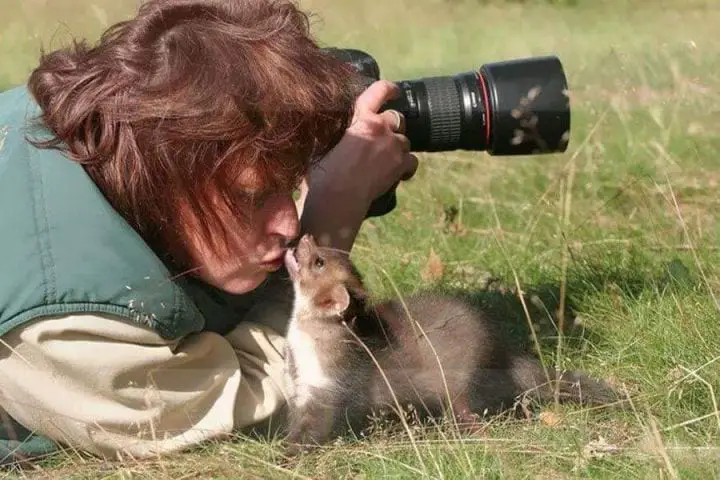
Liba Radova
Since weasels use their slender bodies to squeeze their way through tight spaces after prey, they can’t afford to have baby bumps and instead give birth to extremely small kits. Their offspring are born the size of a paper clip and don’t open their eyes or ears for over a month. But despite the small weasel size, they can take down prey much larger than themselves.
21. It’s hard to take pictures of the animals when they’re climbing on top of you
In a forest on Madagascar, Bobby-Jo Vial led a safari tour through the dense foliage. She spotted a group of lemurs, who then came over to investigate the tourists. They were used to humans and not afraid of climbing all over the people. And hey, we’re basically their relatives, since lemurs are also primates.
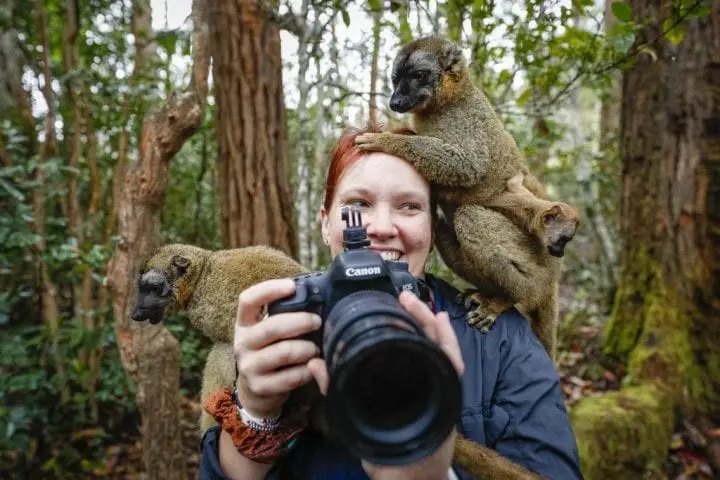
Bobby-Jo Vial
But we’re more like the steal-your-inheritance relatives than the cookie making kind. Most of the forest on Madagascar has been turned into rice farms and charcoal production, so lemur habitat is disappearing. But since the 100-plus different species of lemur only live on Madagascar and a few nearby islands, many of them are threatened with extinction.
22. Hiding from the wildlife only works sometimes
Wildlife photographers often use “hides” when they don’t want to be seen by the wildlife. It can be a lot of work to make them and choose the right place. But sometimes, the hide just doesn’t work. This fox clearly saw something was amiss with this giant igloo that doesn’t really look natural.
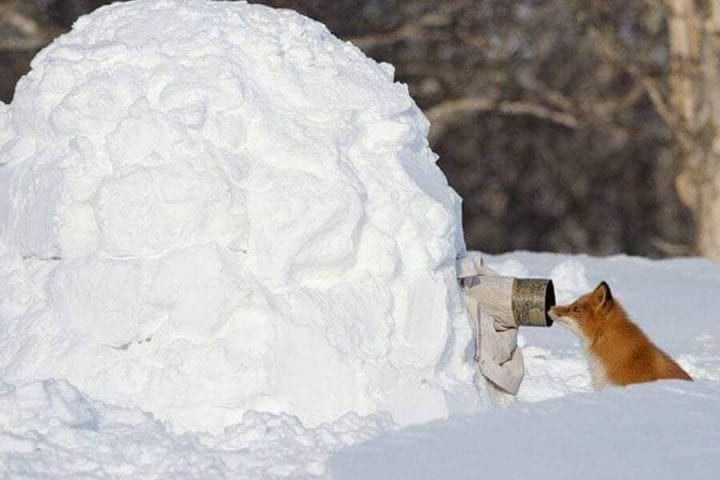
Sure, hides are often meant for getting closer to the wildlife, so technically this one achieved that goal. Hopefully, the photographer got a few good shots before the fox photobombed his own photo shoot. It may look like the best job ever, but no one ever said wildlife photography was easy.
23. “What are you looking at?”
Late at night in dense forests, cold meadows, and murky bogs, a silent hunter stalks its prey. The great grey owl can hear a vole (a type of rodent) two feet under the snow and 100 feet away. The owl swoops in without a sound and snatches the unsuspecting prey.
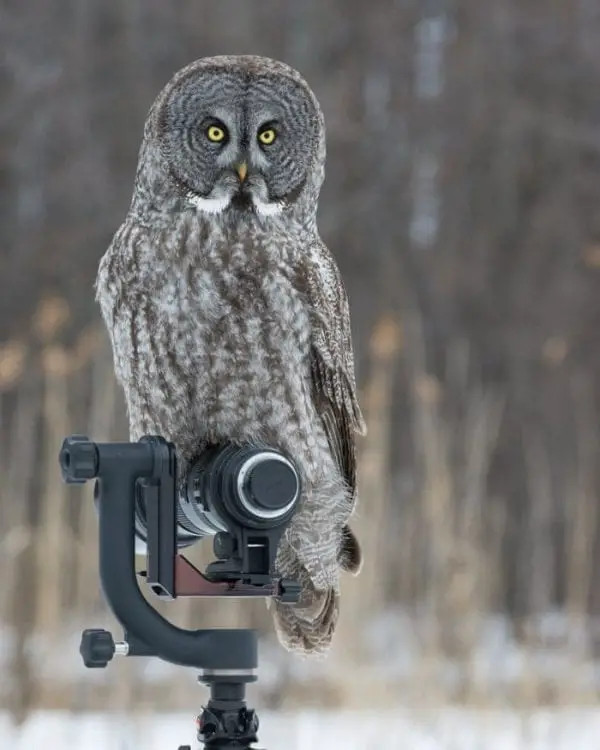
The Afternoon Birder
Like some other owls, great grey owls have asymmetric ear holes to accurately locate their prey. Since these owls are quite elusive, and the photographer did not have cool ears to locate them, he used mice as bait to get the photo. But it can be dangerous getting a predator to associate humans with food, for the animal and the person. These owls may be fluffy, but they’ve also got sharp talons.
24. The photographer looked away for just a second
In between singing Christmas albums and making new record deals, chipmunks also like to try their little hands at photography. There are 25 species of chipmunk and all but one live in North America, ranging from the forest to the desert. Rather than mansions, they live in burrows, bushes, and logs.
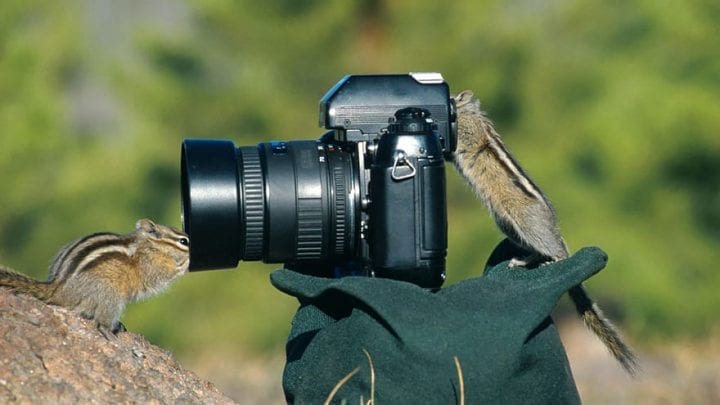
Bored Panda
Throughout the winter, chipmunks hibernate with a stash of nuts and seeds, occasionally waking up for midwinter snacking. Generally, they live alone, so they don’t have to worry about anyone else eating their snacks. As for their photography skills, this little one might want to back up from the lens a bit so it can actually focus.
25. “Argh, my head!” the photographer said, probably
White tigers aren’t albino, but they are rare in the wild because they only get their unusual coloring when two Bengal tigers with the same recessive gene mate. Recessive genes only show physical effects when both parents have that same gene variety, like this one for coat color.
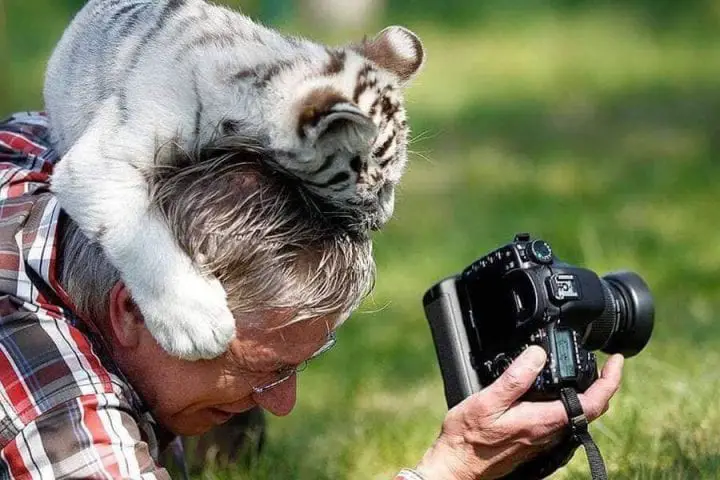
Frank Augustein
Unfortunately, captive white tigers are largely inbred, because people breed them for money. This has given them a lot of health issues, like scoliosis and crossed eyes. The American Zoological Association banned the breeding of white tigers in 2011, but plenty of ethically ambiguous exhibitors still breed them and show them off.
26. “What do you think of this one?”
The word orangutan actually means “person of the forest” in Malaysian and not “bad orange spray tan.” The name makes sense considering that orangutan DNA is 97 percent the same as human DNA and they live high up in the tropical rainforest. They’re smart, too. For example, they use their own versions of umbrellas — large leaves— to shelter from the barrage of rain.
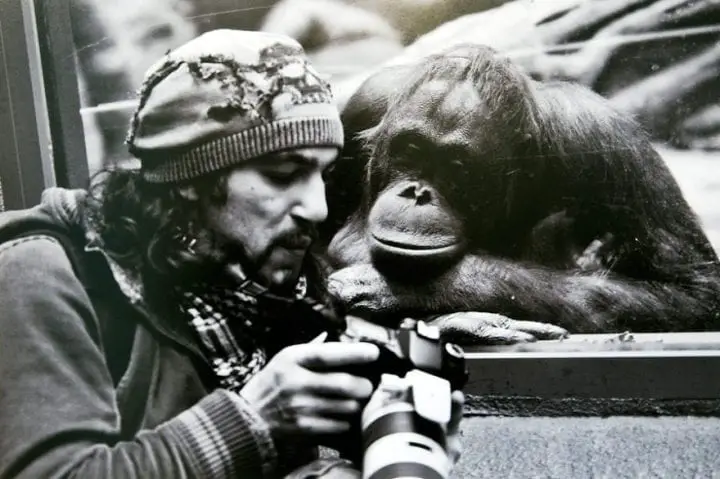
Bored Panda
An orangutan’s arm span is larger than they are tall, at up to seven feet wide. They use their long arms for climbing through the trees they call home. These apes are loners, unlike their relatives the chimpanzees and humans. Female orangutans only give birth once every eight years, staying with their baby for the first six or seven years of their life.
27. Cameras make for the perfect perch
There are almost 60 species of falcon, which all make up the family Falconidae. They are powerful fliers and have long, pointed wings. The smallest falcons are only six inches long, while the largest is about two feet. Often the females are larger than the males. The fastest animal alive is the Peregrine Falcon, which can hit around 200 miles per hour when diving toward prey.
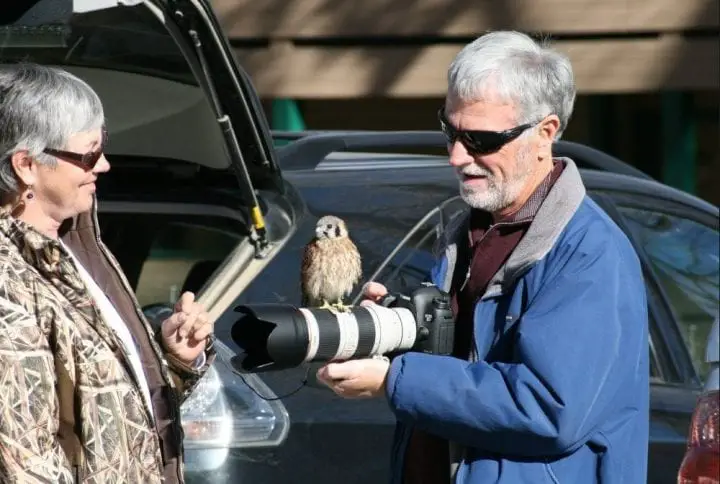
Velvet Sparrow/Twitter
Depending on the species, falcons eat other birds, rabbits, mice, lizards, and insects. Some falcons even catch birds the same size as them. Falcons live in a surprising range of habitats, from the Arctic to forests to deserts. They make their nests on cliff ledges or in holes in trees.
28. Cameras make for very expensive chew toys
Wolves, as top predators, are crucial members of their ecosystems. They control the large population of deer, which in turn keeps deer from overeating the vegetation. When wolves were reintroduced to Yellowstone National Park, after being hunted out of the forest, the plants happily grew back.
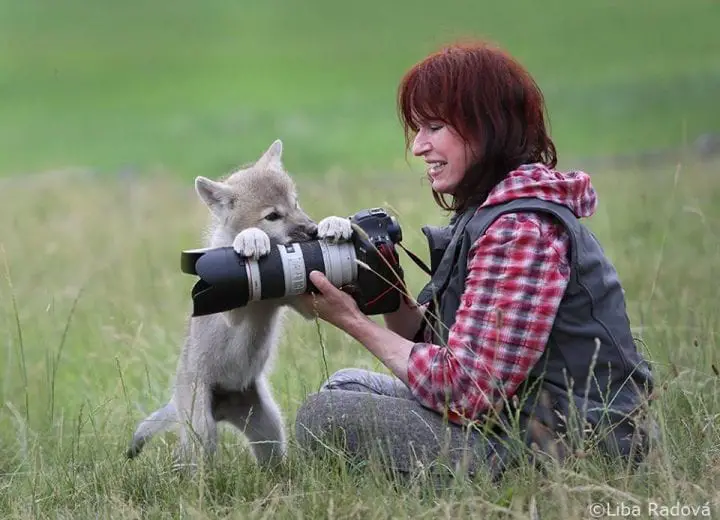
Liba Radova
Wolf packs are run by an alpha male and female, with the rest of the pack usually being their children or other family members. Their pups stick around for a few years, growing up to hunt with the pack. They patrol their territory, scent-marking to keep any other packs out. To keep up the pack’s spirit, wolves howl together.
29. Even underwater photographers find unlikely friends
Gray seals live along the coasts in the North Atlantic, where they use their excellent eyes and ears to hunt fish, squid, and sometimes seabirds. They work together, catching their prey with ease. The gray seal’s scientific name, Halichoerus grypus, means “hook-nosed pig of the sea,” because the males have large snouts.
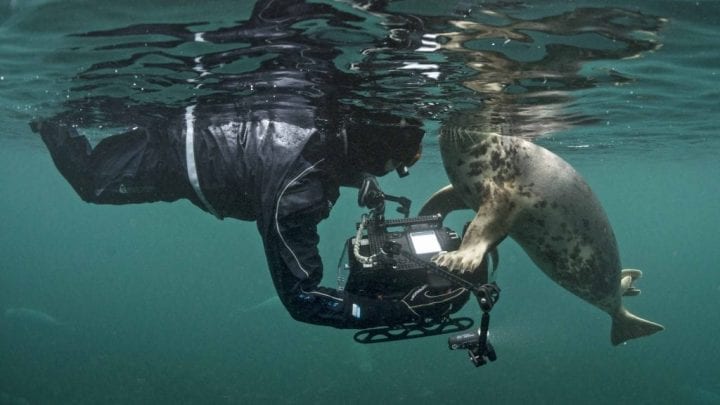
Ellen Cuylaerts
Newborn gray seals weigh a whopping 35 pounds and gain three pounds a day for the next three weeks. The pups are covered in white fur, which absorbs sunlight and traps heat to keep them warm while their thick blubber layer develops. Adult males can weigh more than 850 pounds and be 10 feet long.
30. “He’ll never find me back here.”
Sometimes, when you’re a wildlife photographer and you’ve been waiting hours for the perfect shot, your would-be model sneaks up behind you. This one, for example, is being quite squirrely about being in the limelight. This squirrel seems like he really didn’t want his photo taken.
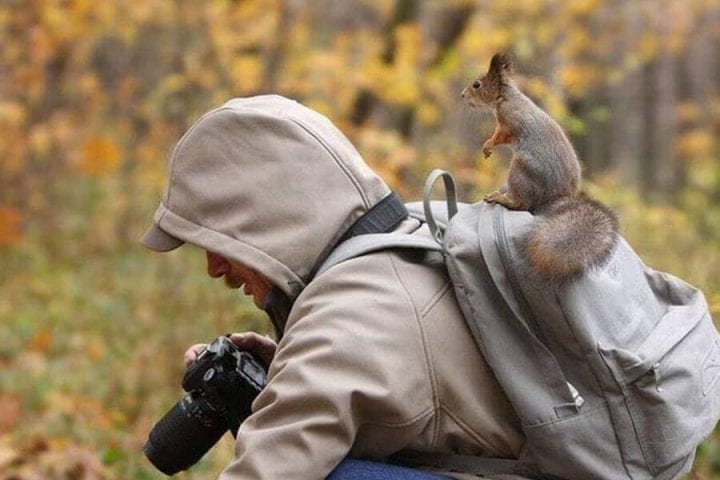
Postfun
Or, maybe the squirrel just wanted a quick peek at what the guy was photographing or perhaps he wanted to make sure he looked good in the picture before it was posted. Either way, despite the frustrations, wildlife photography can be surprising and exciting. You know, in between the boring hours of waiting.